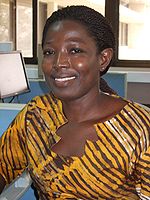Difference between revisions of "User:Helen Atipoka"
| Line 4: | Line 4: | ||
I have an MPhil in Phonetics. The topic of my thesis was spectrographic analysis of Gurene short oral vowels. I did an acoustic description of the vowels of five major dialects of Gurene.The vowels of individual speakers were described by measuring their formant frequencies. The effect of age on formants was investigated and male and female formants compared. | I have an MPhil in Phonetics. The topic of my thesis was spectrographic analysis of Gurene short oral vowels. I did an acoustic description of the vowels of five major dialects of Gurene.The vowels of individual speakers were described by measuring their formant frequencies. The effect of age on formants was investigated and male and female formants compared. | ||
| − | I am currently working on expressions in Gurene that are either prosodically or syntactically prominent and serve in | + | I am currently working on expressions in Gurene that are either prosodically or syntactically prominent and serve in some sense to establish discourse coherence or to stress what in generative grammar is referred to as 'new' information. Being in the first stage of the research, I will for the time being use the term '''Focus''' to refer to the phenomena that I am interested in. |
Focus in Gurene can be marked by the particles ''mɛ'', ''n'', ''ya'', ''ti'', ''ni'',''la'', ''kɔ’ɔm''or ''nuuri'', as well as by vowel lengthening with tone raising at the end of a word. At this point it is unclear if all these particles are really focus markers as some of them seem to have some other grammatical functions. | Focus in Gurene can be marked by the particles ''mɛ'', ''n'', ''ya'', ''ti'', ''ni'',''la'', ''kɔ’ɔm''or ''nuuri'', as well as by vowel lengthening with tone raising at the end of a word. At this point it is unclear if all these particles are really focus markers as some of them seem to have some other grammatical functions. | ||
At present a work on a thorough description of the relevant formatives and their meaning. I will use TypeCraft for a morpheme level annotation of relevant samples of text and discourse and Praat for the phoneme level annotation. | At present a work on a thorough description of the relevant formatives and their meaning. I will use TypeCraft for a morpheme level annotation of relevant samples of text and discourse and Praat for the phoneme level annotation. | ||
Revision as of 13:45, 29 July 2011
My name is Helen Atipoka Adongo and I am a lecturer at the department of Gur-Gonja Education at the University of education,Winneba-Ghana.
I have an MPhil in Phonetics. The topic of my thesis was spectrographic analysis of Gurene short oral vowels. I did an acoustic description of the vowels of five major dialects of Gurene.The vowels of individual speakers were described by measuring their formant frequencies. The effect of age on formants was investigated and male and female formants compared.
I am currently working on expressions in Gurene that are either prosodically or syntactically prominent and serve in some sense to establish discourse coherence or to stress what in generative grammar is referred to as 'new' information. Being in the first stage of the research, I will for the time being use the term Focus to refer to the phenomena that I am interested in.
Focus in Gurene can be marked by the particles mɛ, n, ya, ti, ni,la, kɔ’ɔmor nuuri, as well as by vowel lengthening with tone raising at the end of a word. At this point it is unclear if all these particles are really focus markers as some of them seem to have some other grammatical functions.
At present a work on a thorough description of the relevant formatives and their meaning. I will use TypeCraft for a morpheme level annotation of relevant samples of text and discourse and Praat for the phoneme level annotation.
